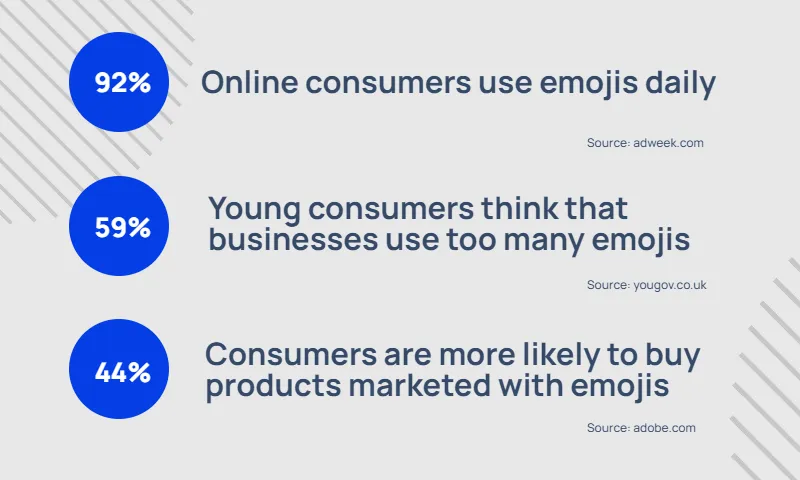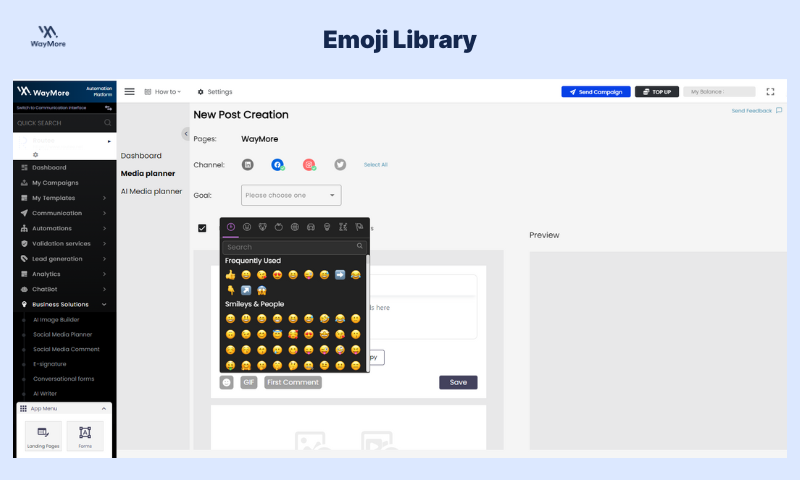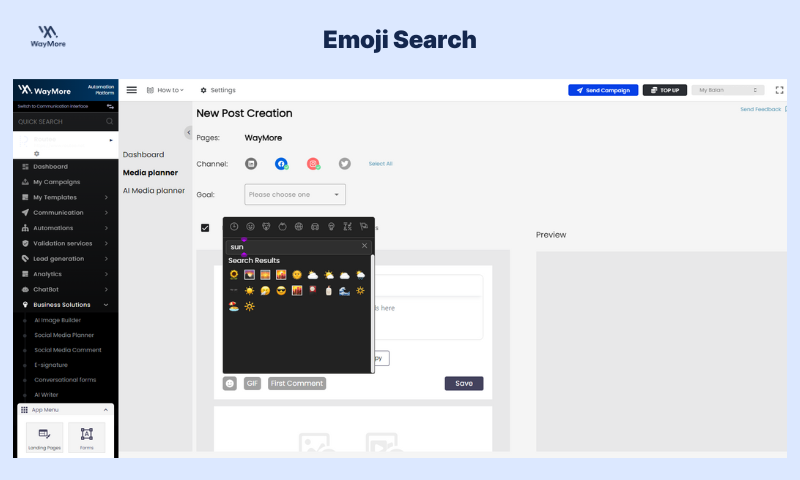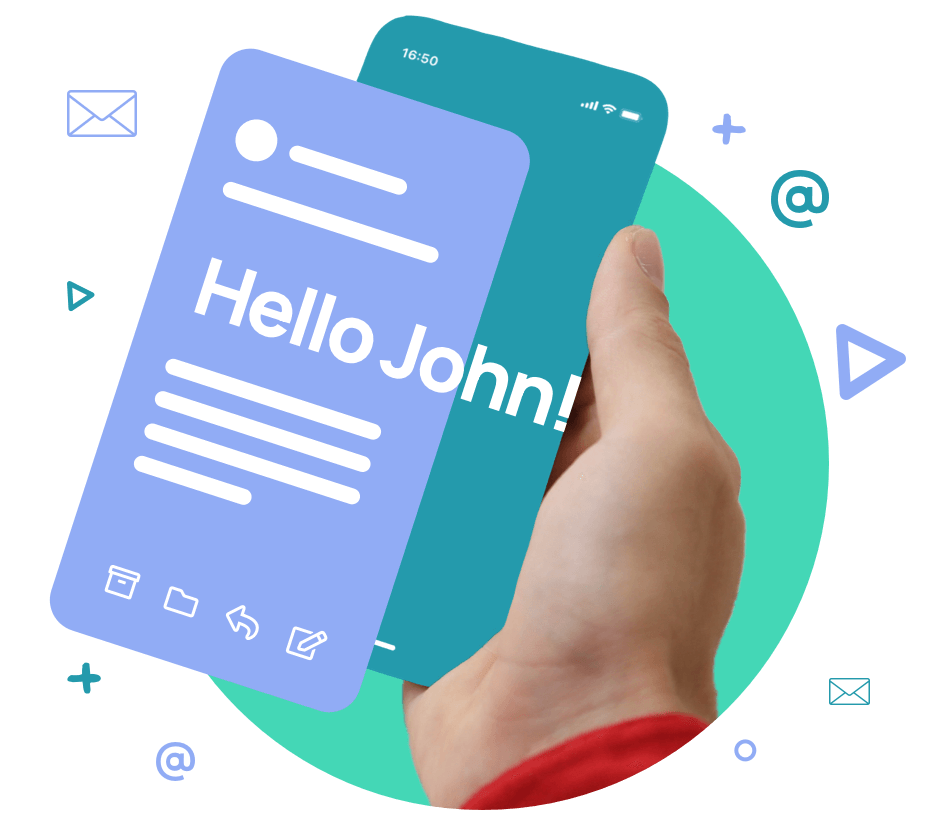Quick Links
Globally, more than 10 billion emojis are exchanged daily. This demonstrates that emojis are more than just cute little pictures. They’ve become a powerful tool for businesses to connect with their audience, add personality to their brand voice, and boost engagement.
Using emojis in business effectively can help you achieve these goals, but just like any other communication tool, there are dos and don’ts to ensure your message lands the right way.
This guide will equip you with the knowledge to master emoji communication in your social media posts.
Why Use Emojis in Social Media Marketing?
Emojis offer several benefits for your social media marketing strategy:
- Increase Engagement: A well-placed emoji can grab attention, spark emotions, and encourage reactions and comments on your posts.
- Boost Brand Personality: Emojis can add a touch of fun, playfulness, or warmth to your brand voice, making you more relatable to your audience.
- Improve Readability: Emojis can break up text-heavy posts, making them easier to read and scan.
- Clarify Your Message: Emojis can add nuance and emphasis to your text, ensuring your message is interpreted correctly.
- Drive Sales: Emojis can make your advertisements more effective, with 44% of consumers more likely to buy products marketed this way.

Dos of Using Emojis in Social Media
1. Choose Emojis Relevant to Your Brand Voice
A lighthearted brand might use emojis like funny faces or celebration icons, while a professional brand might stick to more standard emojis like checkmarks or thumbs up.
2. Use Emojis Sparingly
One or two well-chosen emojis can be impactful, but overloading your post can make it seem cluttered and unprofessional.
3. Consider Your Target Audience
Research the demographics of your audience and choose emojis that are familiar and resonate with them. For example, younger audiences might understand slang emojis that older audiences might not.
Fun fact:
- Millennials emoji when they find something very funny: 🤣
- Gen Z emoji when they find something very funny or cringy: 💀
4.Use Emojis with Correct Meaning
Always double-check the meaning of an emoji before using it. Some emojis can have different interpretations, and you don’t want to inadvertently cause a funny emoji fail (like accidentally using the “eggplant” emoji in a post about healthy eating)!
5.Use Emojis to Complement Your Text
Don’t rely solely on emojis to communicate your message. Use them to enhance your writing, not replace it.
Don'ts of Using Emojis in Social Media
1. Don't Use Emojis You Don't Understand
Misinterpreting an emoji can lead to embarrassing situations or even offend someone.
2. Don't Overuse Emojis
Remember, less is often more. A sea of emojis can be overwhelming and detract from your message. Surprisingly, 59% of young consumers think that businesses use too many emojis in their communications.
3. Don't Use Offensive or Suggestive Emojis
Maintain professionalism and avoid anything that could be construed as inappropriate for your brand.
4. Don't Ignore Cultural Differences
Certain emojis can have different meanings in different cultures. Be mindful of your audience’s background and avoid potentially confusing emojis.
5.Don't Replace Words Entirely with Emojis
While emojis can add nuance, they shouldn’t replace proper communication. Use them to complement your writing, not to substitute it.
Emoji Best Practices to Avoid Mistakes
Here are some additional emoji marketing tips to help you avoid common emoji mistakes and utilize emojis effectively in your social media marketing:
- Stay Up-to-Date: New emojis are released regularly, so keep your emoji knowledge current.
- Pay Attention to Trends: Certain emojis might become trendy for a short period. Consider using them to capitalize on current conversations, but avoid overdoing it.
- Test and Analyze: Track how your audience reacts to your emoji usage. See which emojis lead to higher engagement and adjust your strategy accordingly.
- Use Emojis Consistently: Develop an emoji style guide for your brand to ensure consistent use across all your social media channels.
- Understand Cultural Differences in Emojis: Consider your audience’s background (e.g., Gen Z dislikes “thumbs up”). Align emoji skin tones with your brand voice or use the default yellow. Monitor audience feedback and adapt for inclusivity.
When Not to Use Emojis
While emojis can be a powerful tool, there are situations where it’s best to avoid them altogether. Here are some examples:
- Formal Announcements: For serious announcements or press releases, stick to a professional tone and avoid emojis.
- Sensitive Topics: If you’re discussing a sensitive topic, emojis might come across as insensitive.
- Internal Communication: Internal communication within your company might be better suited for a more formal tone without emojis.
Correct Emoji Use (Made Easy)
Mastering emojis in your social media marketing strategy doesn’t have to be a guessing game. By following these essential dos and don’ts, you’ll be well on your way to crafting clear and engaging content that resonates with your audience.
Remember, emojis are a powerful tool for communication, with a whopping 92% of online consumers using them daily.
To take your emoji game to the next level and ensure consistency across your social media channels, consider exploring social media management tools like WayMore.

These tools can offer a treasure trove of benefits, including extensive emoji libraries, and scheduling functionalities.
This can help ensure consistency and effectiveness in your emoji marketing strategy.

Key Takeaways
Emojis are a valuable tool for businesses looking to connect with their audience and boost engagement on social media. However, it’s crucial to understand the dos and don’ts of using emojis to avoid misunderstandings and ensure your message lands the right way.
By following the best practices outlined in this guide, you can leverage the power of emojis to add personality, clarity, and emotional connection to your social media posts.
It’s crucial to understand the dos and don’ts of using emojis to avoid misunderstandings and ensure your message lands the right way.
Remember:
- Keep your emoji usage relevant to your brand voice and target audience.
- Use emojis sparingly and strategically.
- Be mindful of cultural differences in emoji meanings.
- Don’t rely solely on emojis to communicate your message.
- Stay up-to-date on emoji trends and best practices.
By incorporating these tips, you can transform emojis from a potential pitfall into a powerful asset for your social media marketing strategy.
FAQs
It’s a valid concern! Here are some tips to avoid emoji faux pas:
- Double-check the meaning: Before using an emoji, take a moment to confirm its intended meaning. Some emojis can have multiple interpretations, so a quick search can save you from a misunderstanding.
- Stick to familiar territory: When in doubt, choose emojis that are widely understood and less likely to be misinterpreted. Classic emojis like thumbs up () or smiley faces () are always safe bets.
- Consider your audience: If you’re targeting a specific demographic, research popular emojis within that group. For example, younger audiences might understand slang emojis that older audiences might not.
Less is often more! A well-placed emoji can add personality and emphasis, but overloading your post can make it seem cluttered and unprofessional. Generally, one or two emojis are sufficient.
Yes, there are times when emojis might not be the best choice. Here are a few examples:
- Formal announcements: For serious press releases or important updates, stick to a professional tone and avoid emojis.
- Sensitive topics: If you’re discussing a delicate subject, emojis might come across as insensitive.
- Internal communication: Internal messages within your company might be better suited for a more formal tone without emojis.
Bonus Tip: Stay on Top of Emoji Trends
The world of emojis is constantly evolving, with new additions and changing usage patterns. To stay ahead of the curve, consider using social media management tools like WayMore Social Media Management. These tools can offer up-to-date emoji libraries, helping you ensure your emoji choices are relevant and engaging for your audience. WayMore can also help you schedule your posts, so you can focus on crafting the perfect message without worrying about timing.
By following these tips, you can leverage the power of emojis to add personality and engagement to your social media content while avoiding any potential pitfalls.
Curious to find out all the ways WayMore can help your brand grow? Book an appointment with our experts today!




